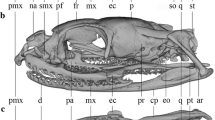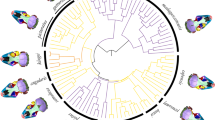Abstract
Allometric growth is one of the dominant factors of morphological variation, although this issue is still poorly explored. Using geometric morphometrics, we evaluated and described the ontogenetic allometry in the skull of the snake Hydrodynastes gigas. Furthermore, we described the skull morphology of the species and compared it with its congener, H. bicinctus. We found that 46.91 % of shape variation was explained by allometry: smaller centroid sizes were mostly correlated to short postorbital process, medial region of frontals elongated, shortened nasals and elongated parietal, and shortened/oblique supratemporals in relation to the anteroposterior axis of the skull; larger centroid sizes point mainly to postorbital process elongated, elongated nasals and shortened parietals, posterior region of parietal strongly tapered, and elongated/parallel supratemporals in relation to the anteroposterior axis of the skull. In general aspect, the skull of H. gigas differs from the skull of H. bicinctus by being less dorsoventrally compressed. Comparisons between our results and the results of other studies which considered allometry in specific bones of snakes’ skull showed some common patterns, although we found a different correlation between parietal and skull length. These results reinforce the importance of further studies to evaluate the existence of recurrent patterns of allometric growth in the skull of other representatives of this group of snakes. Moreover, the analyses presented herein revealed a significant ontogenetic allometry in the skull of H. gigas and represent the first approach of geometric morphometrics with this goal for snakes.







Similar content being viewed by others
References
Bell CJ, Mead JI (2014) Not enough skeletons in the closet: collections-based anatomical research in an age of conservation conscience. Anat Rec 297:344–348. doi:10.1002/ar.22852
Blanco MVF, Bona P, Olivares AI, Desojo JB (2015) Ontogenetic variation in the skull of Caiman: the case of Caiman latirostris and Caiman yacare (Alligatoridae, Caimanidae). Herpetol J 25:65–73
Bookstein FL (1991) Morphometric tools for landmark data. Geometry and biology. Cambridge University Press, New York
Cardini A, O’Higgins P (2005) Post-natal ontogeny of the mandible and ventral cranium in Marmota species (Rodentia; Sciuridae): allometry and phylogeny. Zoomorphology 124:189–203. doi:10.1007/s00435-005-0008-3
Carrasco P, Mattoni CI, Leynaud GC, Scrocchi GJ (2012) Morphology, phylogeny and taxonomy of South American bothropoid pitvipers (Serpentes, Viperidae). Zool Scr 41:109–124. doi:10.1111/j.1463-6409.2011.00511.x
Cock AG (1966) Genetical aspects of metrical growth and form in animals. Q Rev Biol 41:131–190
Cundall D, Irish F (2008) The snake skull. In: Gans C, Gaunt AS, Adler K (eds) Biology of the reptilia. Morphology H, the skull of Lepidosauria, vol 20. Society for the Study of Amphibians and Reptiles, Ithaca, pp 349–692
Daltry JC, Wuster W, Thorpe RS (1998) Intraspecific variation in the feeding ecology of the Crotaline snake Calloselasma rhodostoma in southeast Asia. J Herpetol 32:198–205
Dowling HG, Gibson FW (1970) Relationship of the neotropical snakes Hydrodynastes bicinctus and Cyclagras gigas. Herpetol Rev 2:37–38
Duméril AMC, Bibron G, Duméril A (1854) Erpétologie Genérale ou Histoire naturelle complete des reptiles, vol 7. Librairie Encyclopédique de Roret, Paris. doi:10.5962/bhl.title.100816
Fenwick AM, Gutberlet RL Jr, Evans JA, Parkinson CL (2009) Morphological and molecular evidence for phylogeny and classification of South American pitvipers, genera Bothrops, Bothriopsis, and Bothrocophias (Sepentes: Viperidae). Zool J Linnean Soc 156:617–640. doi:10.1111/j.1096-3642.2008.00495.x
Franco FL, Fernandes DS, Bentim BM (2007) A new species of Hydrodynastes Fitzinger, 1843 from central Brazil (Serpentes: Colubridae: Xenodontinae). Zootaxa 1613:57–65
Garcia CM, Drummond H (1988) Seasonal and ontogenetic variation in the diet of the mexican garter snake, Tamnophis eques, in lake Tecocomulco, Hidalgo. J Herpetol 22:129–134
Gentilli A, Cardini A, Fontaneto D, Zuffi MAL (2009) The phylogenetic signal in cranial morphology of Vipera aspis: a contribution from geometric morphometrics. Herpetol J 19:69–77
Hampton PM (2014) Allometry of skull morphology, gape size and ingestion performance in the banded watersnake (Nerodia fasciata) feeding on two types of prey. J Exp Biol 217:472–478. doi:10.1242/jeb.092924
Hermann J (1804) Observations zoologicae quibus novae complures, aliaeque animalium species describuntur et illustrantur, Opus Posthumus. In: Hammer FL (ed) Pars prior, observationum quatuor centurias continens, Part 3. Argentorati apud Amandus Koenig, Paris, p 332
Jan G, Sordelli F (1876) Iconographie générale des ophidiens. Tome troisième, livro 48. J. B. Baillière et Fils, Paris
Kaliontzopoulou A (2011) Geometric morphometrics in herpetology: modern tools to enhancing the study of morphological variation in amphibians and reptiles. Basic Appl Herpetol 25:5–32
Klingenberg CP (1998) Heterochrony and allometry: the analysis of evolutionary change in ontogeny. Biol Rev 73:79–123
Klingenberg CP (2008) MorphoJ. Faculty of life sciences. Manchester: University of Manchester. http://www.flywings.org.uk/MorphoJ_page.htm
Klingenberg CP (2010) Evolution and development of shape: integrating quantitative approaches. Nature 11:623–634. doi:10.1038/nrg2829
Kluge AG (1993) Aspidites and the phylogeny of pythonine snakes. Rec Aust Mus 19:1–77
Knigge RP, Tocheri MW, Orr CM, Mcnulty KP (2015) Three-dimensional geometric morphometric analyses of talar morphology in extant gorilla tava form highland and lowland habitats. Anat Rec 298:277–290. doi:10.1002/ar.23069
Knox A, Jackson K (2010) Ecological and phylogenetic influences on maxillary dentition in snakes. Phyllomedusa 9:121–131
Larson PM (2002) Chondocranial development in larval Rana sylvatica (Anura: Ranidae): morphometric analysis of cranial allometry and ontogenetic shape change. J Morphol 252:131–144. doi:10.1002/jmor.1095
Lee MSY, Scanlon JD (2002) Snake phylogeny based on osteology, soft anatomy and ecology. Biol Rev 77:333–401. doi:10.1017/S1464793102005924
Lee MSY, Hugall AF, Lawson R, Scanlon JD (2007) Phylogeny of snakes (Serpentes): combining morphological and molecular data in likelihood, Bayesian, and parsimony analyses. Syst Biodivers 5:371–389. doi:10.1017/S1477200007002290
López MS, Manzano AS, Prieto YA (2013) Ontogenetic variation in head morphology and diet in two snakes (Viperidae) from Northeastern Argentina. J Herpetol 47:406–412. doi:10.1670/12-007
Mangiacotti M, Limongi L, Sannolo M, Sacchi R, Zuffi MAL, Scali S (2014) Head shape variation in eastern and western Montpellier snakes. Acta Herpetol 9:167–177. doi:10.13128/Acta_Herpetol-14194
Manier MK (2004) Geographic variation in the long-nosed snake, Rhinocheilus lecontei (Colubridae): beyond the subspecies debate. Biol J Linn Soc 83:65–85
Meik JM, Lawing AM, Silva P (2010) Body size evolution in insular speckled rattlesnake (Viperidae: Crotalus mitchellii). PLoS One 5:e9524. doi:10.1371/journal.pone.0009524
Meyer A (1990) Morphometrics and allometry in the trophically polymorphic cichlid fish, Cichlasoma citrinellum: alternative adaptations and ontogenetic changes in shape. J Zool 221:237–260. doi:10.1111/j.1469-7998.1990.tb03994.x
Monteiro LR, Reis SF (1999) Princípios de Morfometria Geométrica. Ribeirão Preto, Holos editora, p 198
Monteiro LR, Beneditto APMD, Guillermo LH, Rivera LA (2005) Allometric changes and shape differentiation of sagitta otoliths in sciaenid fishes. Fishes Res 74:288–299. doi:10.1016/j.fishres.2005.03.002
Murta-Fonseca RA, Franco FL, Fernandes DS (2015) Taxonomic status and morphological variation of Hydrodynastes bicinctus (Hermann, 1804) (Serpentes: Dipsadidae). Zootaxa 4007:63–81. doi:10.11646/zootaxa.4007.1.4
Natusch DJD, Lyons JA (2012) Relationship between ontogenetic changes in prey selection, head shape, sexual maturity, and colour in Australasian python (Morelia viridis). Biol J Linn Soc 107(2):269–276. doi:10.1111/j.1095-8312.2012.01941.x
Ponssa ML, Vera Candioti MF (2012) Patterns of skull development in anurans: size and shape relationship during postmetamorphic cranial ontogeny in five species of Leptodactylus fuscus Group (Anura: Leptodactylidae). Zoomorphology 131(4):349–362. doi:10.1007/s00435-012-0164-1
Prevosti FJ, Turazzini GF, Ercoli MD, Hingst-Zaher E (2012) Mandible shape in marsupial and placental carnivorous mammals: a morphological comparative study using geometric morphometrics. Zool J Leannen Soc 164:836–855
Rohlf FJ (2008) TpsUtil, ver. 1.40. Department of Ecology and Evolution, State University of New York at Stony Brook, Stony Brook
Rohlf FJ (2010) TpsDig, ver. 2.1. Ecology and evolution. State University of New York at Stony Brook, Stony Brook
Rohlf FJ, Slice D (1990) Extensions of the procrustes method for the optimal superimposition of landmarks. Syst Zool 39:40–59. doi:10.2307/2992207
Rossman CE (1980) Ontogenetic changes in skull proportions of the diamondback water snake, Nerodia rhombifera. Herpetologica 36:42–46
Ruane S (2015) Using geometric morphometrics for integrative taxonomy: an examination of head shape of milksnakes (Lampropeltis). Zool J Linn Soc 174(2):394–413. doi:10.1111/zoj.12245
Sarris I, Marugán-Lobón J, Chamero B, Buscalioni AD (2012) Shape variation and allometry in the precloacal vertebral series of the snake Duboia russeli (Viperidae). Int J Morphol 30:1363–1368
Sazima I, Strussman C (1990) Necrofagia em serpentes brasileiras: exemplos e previsões. Rev Bras Biol 50:463–468
Schuett GW, Hardy SDL, Earley RL, Greene HW (2005) Does prey size induce head skeleton phenotypic plasticity during early ontogeny in the snake Boa constrictor? J Zool Lond 267:363–369. doi:10.1017/S0952836905007624
Strussman C, Sazima I (1990) Esquadrinhar com a cauda: uma tática de caça da serpente Hydrodynastes gigas no pantanal, Mato Grosso. Mem I Butantan 52:57–61
Vincent SE, Herrel A, Irschick DJ (2004) Ontogeny of intersexual head shape and prey selection in the pitviper Agkistrodon piscivorus. Biol J Linn Soc 81:151–159. doi:10.1111/j.1420-9101.2006.01126.x
Vincent SE, Moon BR, Herrel A, Kley NJ (2007) Are ontogenetic shifts in diet linked to shifts in feeding mechanics? scaling of the feeding apparatus in the banded watersnake Nerodia fasciata. J Exp Biol 210:2057–2069. doi:10.1242/jeb.02779
Zeffer A, Johansson C, Marmebro A (2003) Functional correlation between habitat use and leg morphology in birds (Aves). Biol J Linn Soc 79:461–484. doi:10.1046/j.1095-8312.2003.00200.x
Zelditch ML, Swiderski DL, Sheets HD, Fink WL (2004) Geometrics morphometrics for biologists: a primer. Elsevier, San Diego
Acknowledgments
We thank Coordenação de Aperfeiçoamento de Pessoal de Nível Superior (CAPES) for financial support to RAMF. We are grateful to Fundação Carlos Chagas Filho de Amparo à Pesquisa do Estado do Rio de Janeiro (FAPERJ) and Conselho Nacional de Desenvolvimento Científico e Tecnológico (CNPq) for financial support. We are grateful to S. Kretzschmar (FML) for allowing access to the specimens under her care. Furthermore, we thank J. Fratani, M. F. Vera Candioti, A. P. Motta, and two anonymous reviewers for valuable suggestions on the manuscript.
Author information
Authors and Affiliations
Corresponding author
Ethics declarations
Conflict of interest
The authors declare that they have no conflict of interest.
Human and animals rights
This article does not contain any studies with human participants or animals performed by any of the authors.
Additional information
Communicated by A. Schmidt-Rhaesa.
Rights and permissions
About this article
Cite this article
Murta-Fonseca, R.A., Fernandes, D.S. The skull of Hydrodynastes gigas (Duméril, Bibron & Duméril, 1854) (Serpentes: Dipsadidae) as a model of snake ontogenetic allometry inferred by geometric morphometrics. Zoomorphology 135, 233–241 (2016). https://doi.org/10.1007/s00435-015-0297-0
Received:
Revised:
Accepted:
Published:
Issue Date:
DOI: https://doi.org/10.1007/s00435-015-0297-0




